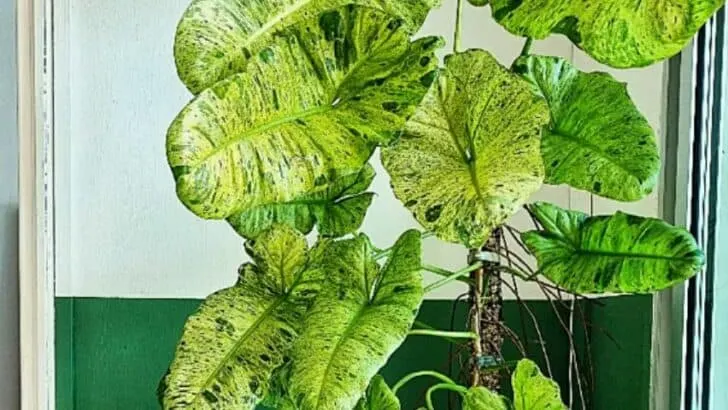A rare and stunning Philodendron is the Philodendron Paraiso Verde plant.
Its marbled, variegated foliage is what has made it so popular.
The Paraiso plant is a prominent but relatively rare variety of the Philodendron family.
It is naturally cultivated in the tropical regions of the West Indies and America.
Aka the Marina Ruy Barbosa, its name means ‘Paradise’ in Spanish.
To learn how to grow this beauty at home, keep on reading.
Table of Contents
Philodendron Paraiso Verde Care
The Philodendron Paraiso hails from tropical regions, requiring bright, dappled sunlight and warm temperatures between 64-98 degrees Fahrenheit (18-32 degrees Celsius). This Philodendron thrives in moist environments and humidity levels of 60% to 70%. Water the Paraiso plant when its soil’s top 2 to 3 inches (5-7.6 cm) are slightly dry about once a week. Use a balanced fertilizer with an NPK ratio of 20:20:20 every 4 weeks in spring and summer and every 6-8 weeks in autumn and winter.
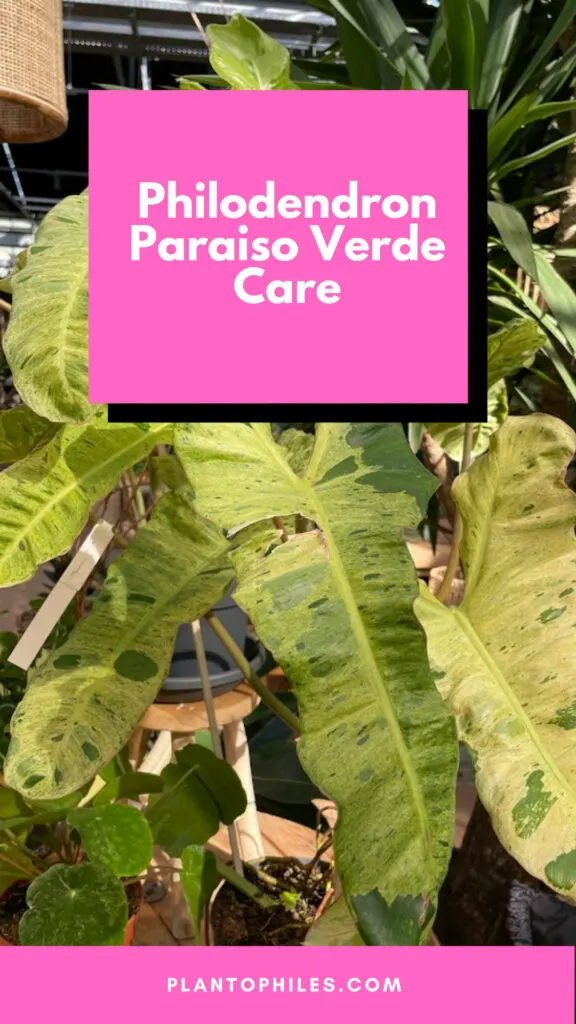
Soil
The Philodendron Paraiso plant thoroughly enjoys light and nutritious soils. Like other Philodendrons, it thrives in lightweight and permeable soils high in organic matter and draining well.
The Paraiso plant is quite sensitive to root rot; therefore, I recommend using well-aerated soils only.
Apart from using loose soils, you can add peat moss, which prevents the soil from drying out quickly. Other options include perlite, charcoal, and coconut fiber.
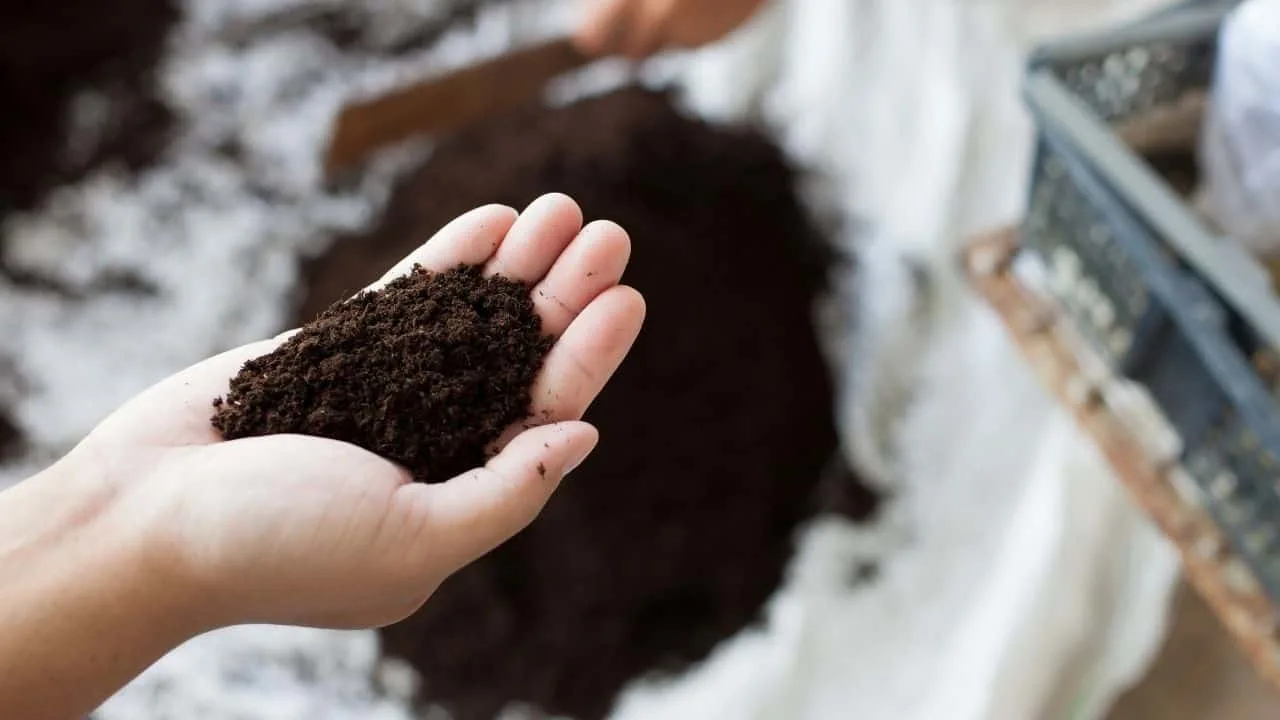
The latter options are highly effective at filtering out toxins from the soil.
For the healthiest growth, maintain a pH level of 5.0 to 6.0 (mildly acidic). The low acidity helps the plant flourish while saving it from mild infections and diseases.
Furthermore, it helps the Philodendron Paraiso plant take in nutrients efficiently.
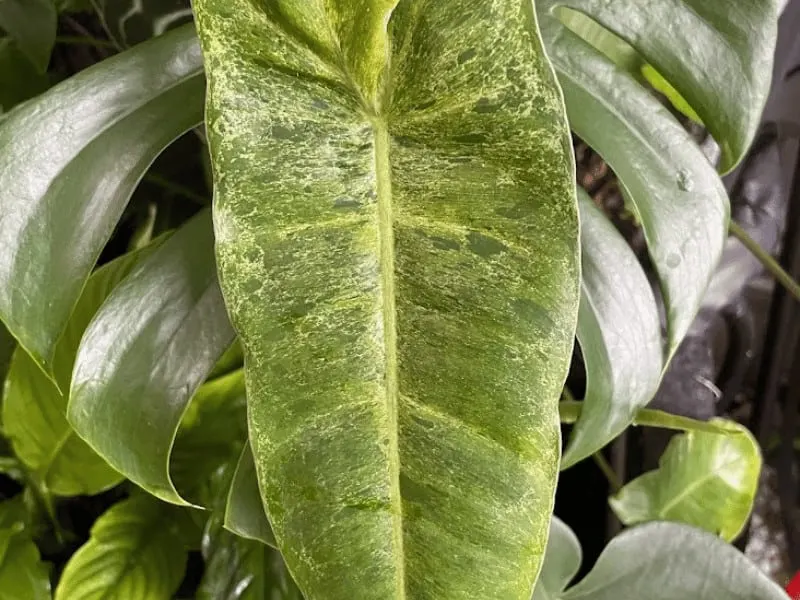
Water
Philodendrons are pretty tolerant of unfavorable water conditions; however, the Philodendron Paraiso plant, in particular, is quite the opposite.
It is quick to react to both overwatering as well as underwatering. If watered incorrectly, you will likely see signs such as yellow leaves, stunted growth, and drooping foliage.
To save the Philodendron Paraiso plant from reaching both extremes, maintain a medium watering schedule. Ideally, water the Paraiso plant when its soil’s top 2 to 3 inches are slightly dry.
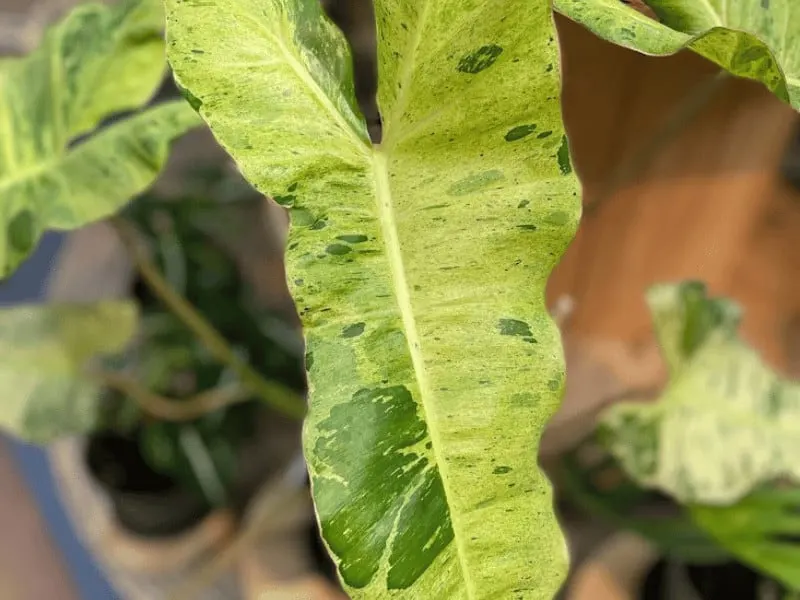
This means watering around once a week, depending on your environment.
Water the plant from the top, ensuring it reaches all parts.
Keep adding water until it comes out of the pot’s bottom holes. However, if you see any water accumulating at the bottom, discard it immediately.
I also suggest using chlorine-free water.
If you only have access to chlorinated water, fill a bucket with the required amount of water, and let it sit overnight. This allows the excess chlorine to be eliminated overnight.
Light
The Philodendron Paraiso plant arises from tropical lands; thus, I recommend placing it in bright, indirect sunlight. East and south-facing windows often offer the most appropriate light.
If your windows offer direct sunlight only, put a shade over them, for instance, a thin white curtain.
Alternatively, you can grow the Philodendron Paraiso plant under artificial growing lights. In contrast, if you are growing the Paraiso plant outdoors, place it on a shaded balcony or a covered patio.
If placed in low light, the Philodendron Paraiso plant frequently shows signs, including yellow leaves and slow growth.
Place the Philodendron Paraiso plant in bright, dappled sunlight for the healthiest growth.
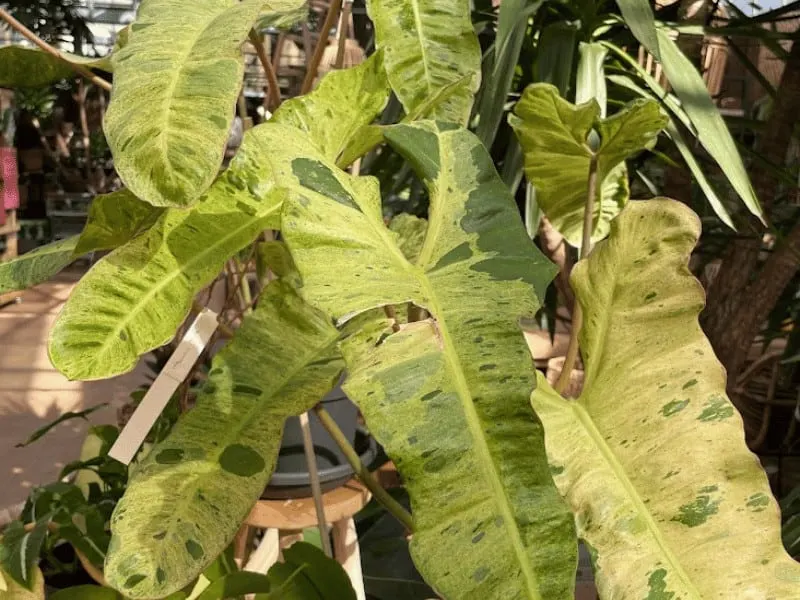
Temperature
I recommend growing the Philodendron Paraiso Verde between 64 – 98 degrees Fahrenheit (18 – 32 degrees Celsius).
If put in low temperatures, the Philodendron Paraiso plant grows erratically and produces fewer leaves.
Moreover, you will also encounter more problems, such as greater infection susceptibility.
Humidity
The Philodendron Paraiso plant naturally grows in warm, humid areas. It does not enjoy regular rains; however, long, dry spells cause issues.
The good news is that though average humidity is ideal, it can also do pretty well in low humidity.
Ideally, maintain a humidity of about 60% to 70%; this allows the plant to maintain its normal shape while staying fresh and hydrated.
A good way to grow a healthy Philodendron Paraiso plant is to install a humidifier in your house.
In the winter, you may have trouble maintaining this level. However, do not fret; you can mist it every other day.
Additionally, you can bring it indoors in a warmer environment to avoid frost.
Alternatively, you can place the Philodendron Paraiso plant with all your other plants. This allows for fair humidity distribution.
However, infections quickly spread in such settings, so I suggest keeping a close eye on each plant.
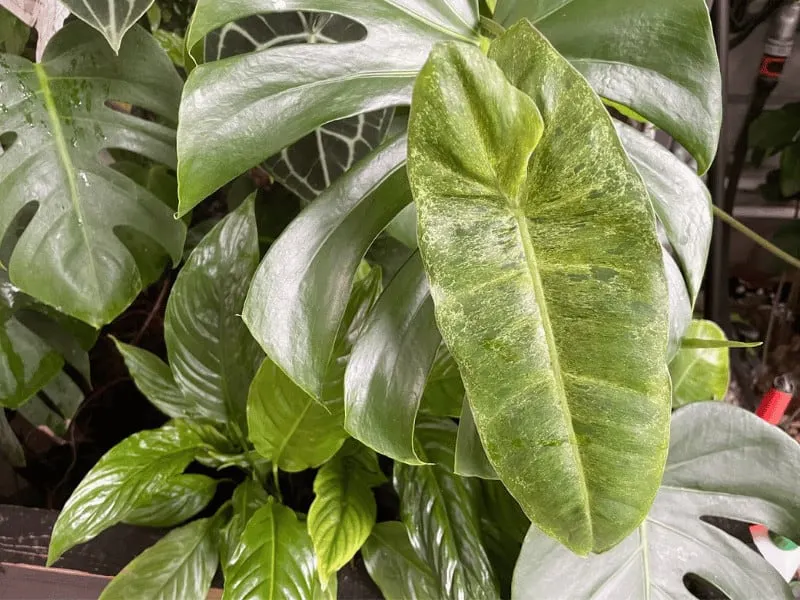
Fertilizer
The Philodendron Paraiso plant is not a heavy fertilizer, another reason it is a grower-friendly choice. You can feed it with liquid, quick-release fertilizers, or slow, powder feeds.
I recommend getting premium-quality fertilizers with an NPK (Nitrogen, Phosphate, Potassium) of 20:20:20. The same amount of each of these macronutrients helps the plant reach its full potential.
For added benefit, use feeds with plenty of micronutrients as well.
In the summers, feed the Philodendron Paraiso plant every four to five weeks. In the colder seasons, bring down this frequency to about six to eight weeks.
If you see signs such as discolored leaves or wilting, go over your feeding schedule and make changes appropriately.
If you prefer homemade fertilizers, you can easily make one with coffee grounds. Simply mix some coffee with eggshells and banana peels and apply this over the plant’s soil.
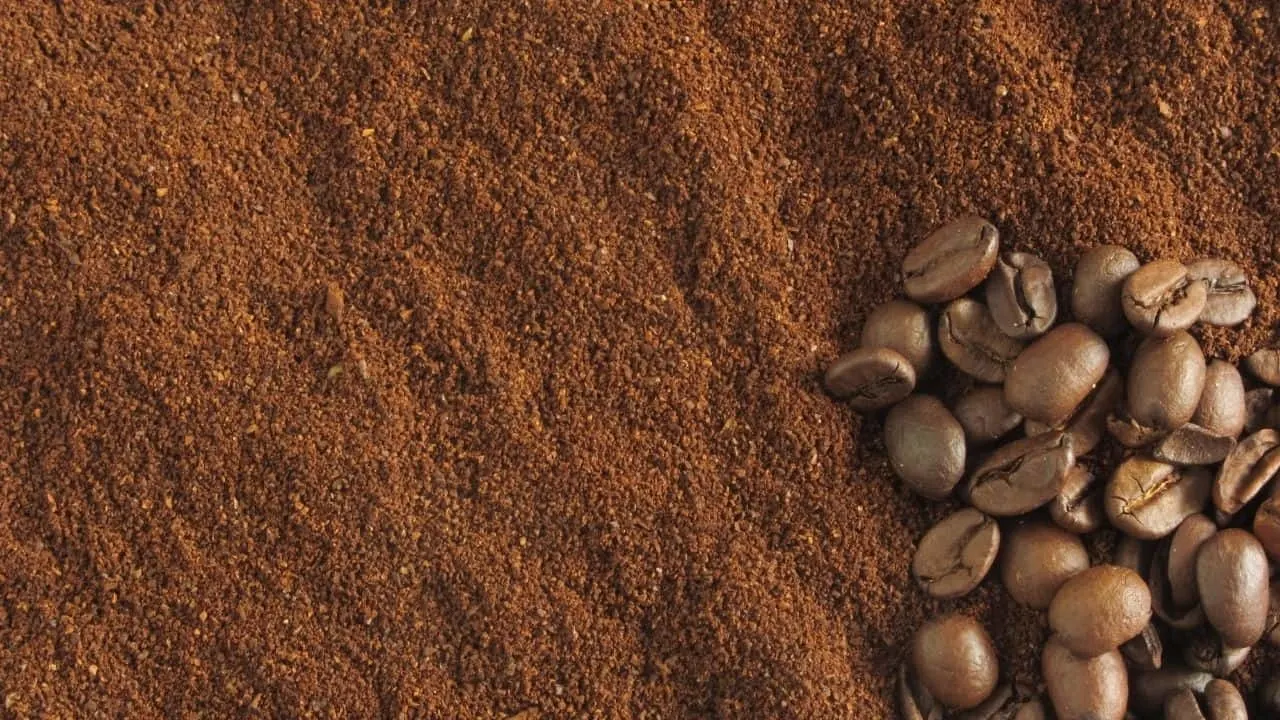
Repotting
Overall, growing the Philodendron Paraiso plant is manageable; however, repotting is one thing you must take care of.
If too tight in its pot, the Paraiso plant’s roots will undergo rotting, or the tropical beauty will stop growing.
Repot the Philodendron Paraiso plant when you see its roots circling its pot or when you think it is growing slower than usual.
Take a pot at least 2 inches (5 centimeters) bigger than the previous one. Once you are done repotting, fill the pot with the appropriate soil mix again.
I also advise repotting in the spring season. And soon after repotting, keep a close eye on the Philodendron Paraiso plant and watch out for any signs of stress.
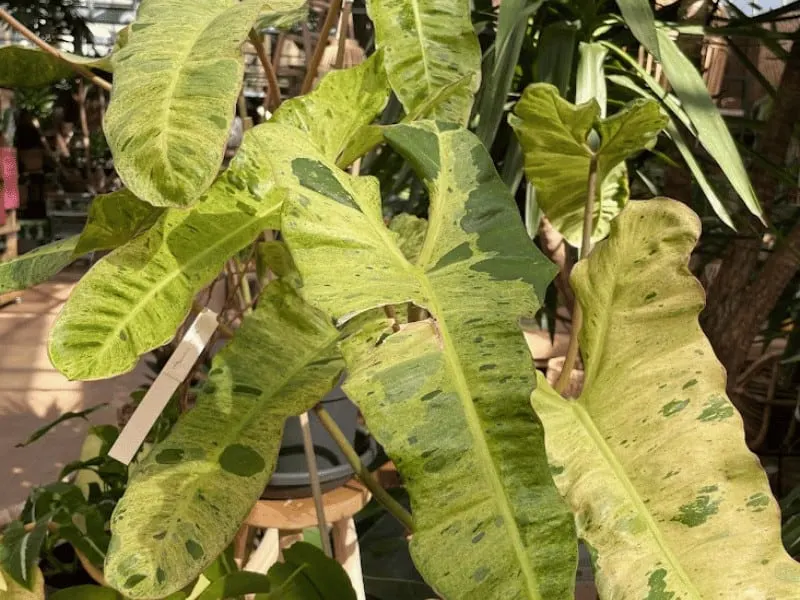
Pruning
If your Philodendron Paraiso plant has a lot of irregular vines, prune it every few weeks for a neat and clean look.
On the other hand, if you think the vines are too small and look well, skip pruning until they grow longer.
When pruning, use some rubbing alcohol on your pruning shears beforehand. Moreover, as you review your Philodendron Paraiso plant, look for any signs of disease, such as necrotizing spots or similar abnormal changes.
The periodical pruning will help your plant grow new, healthier leaves, become bushier, and redirect its nutrient supply to juvenile vines.
A tip here is to always pinch or cut right above the leaf node, which is the point from where a new leaf or stem grows.
Propagation
Perhaps one disadvantage of growing the Philodendron Paraiso plant is that you cannot grow it from seeds.
It must be propagated from a stem cutting and ideally grown outdoors, where it is much more likely to flower.
The best time for propagating the Philodendron Paraiso plant is in spring and when the parent plant is at its full, mature size.
Follow these steps for successful propagation:
- Start by cutting a branch off a healthy Philodendron Paraiso plant. Ideally, choose one that has at least two roots present. But, separating the root ball into sections is another option.
- Use rooting and fungicide powder over this branch to remove all possible pathogenic organisms.
- Now place this branch in a bowl of water with sandy peat or a few pieces of charcoal or sandy peat. Make sure you dust off all the fungicide powder.
- Put this bowl at an average temperature (70 to 70 degrees Fahrenheit).
- Let this bowl sit for a few days until you see new growth. Transfer the branch into a good soil mixture when shoots and roots are growing.
- After a few more days, place the Philodendron Paraiso plantlet in warm temperatures until it matures.
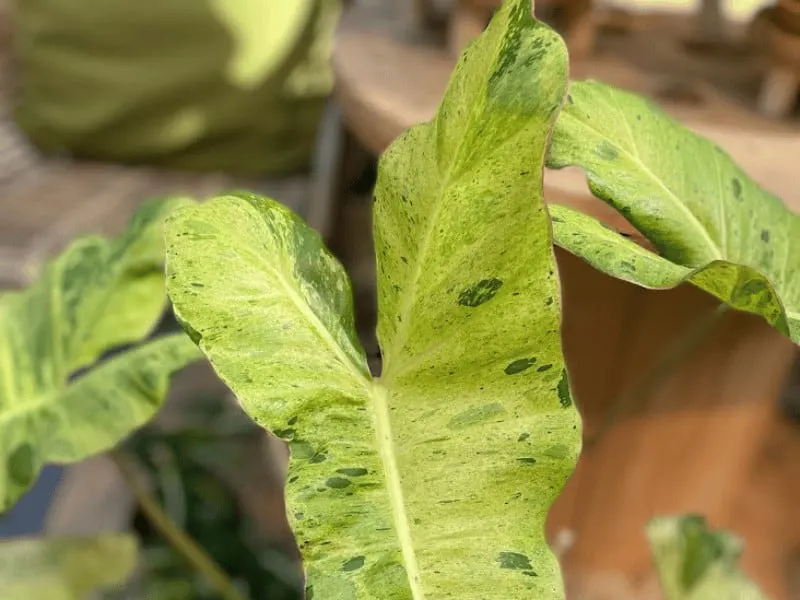
Blooms
There is very limited information about the Philodendron Paraiso plant’s blooms. Ask your local gardener shop if it produces flowers when buying a particular type.
If the Philodendron Paraiso plant does bloom, grow it outside, where the environment is warmer and more humid.
Growth
The Philodendron Paraiso plant’s growth is largely dependent on its surroundings. If the settings are ideal, it flourishes within a few weeks.
In contrast, the plant may not grow even after months if unfavorable.
The Philodendron Paraiso plant reaches heights of about 10 to 15 inches (25 to 38 centimeters).
It spreads to about 15.7 to 23.6 inches (40 to 60 centimeters) and grows actively through USDA hardiness zones 9 to 11.
The leaves are marbled and extend to about 7 to 10 inches (17.7 to 25.4 centimeters), depending on the plant’s care routine.
Common Problems for Philodendron Paraiso Plant
Aphids
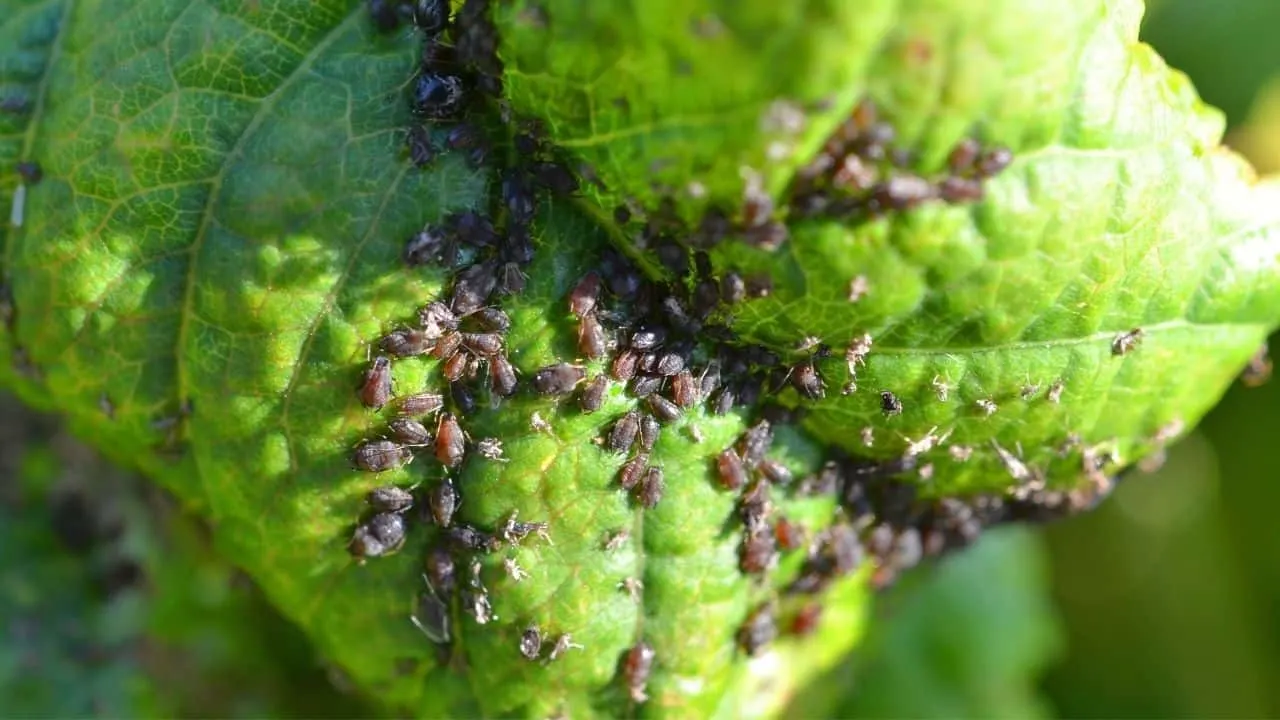
If you see small, fast insects running over your Philodendron Paraiso plant’s leaves, there is a high chance it is Aphids.
These tiny sap-sucking pests attack all parts but tend to attack the soft parts more often.
Once they establish themselves, they multiply quickly, giving the grower a very short time to treat the Philodendron Paraiso plant. They suck the plant’s cell sap, stunting its growth significantly.
To rid the plant of Aphids, treat it with neem oil or use a bar of insecticidal soap on the plant.
Mealybugs
Another group of pests that eagerly feasts on the Philodendron Paraiso plant is mealybugs. These are small insects that resemble a light dusting of flour or tiny cotton wool blobs.
They often hide in leaf joints, feeding the plant’s sap or crawling all over it.
Blast the mealybugs with a fast water jet or use neem oil on the plant to eliminate them. Additionally, isolate the Philodendron Paraiso plant till it recovers fully.
Brown Leaf Tips
Brown leaf tips are one of the primary signs of underwatering. The discoloration extent is proportional to the degree of dehydration.
As the condition worsens, the brown tips become dry and crispy. Eventually, the leaf falls off the plant.
Unfortunately, you cannot save the dead leaves. However, reestablishing normal hydration levels can prevent the problem from worsening.
Please rule out other reasons for brown tips, including bacterial and fungal infections.
Moreover, ensure good air circulation and water when needed. I also suggest using a fungicide spray on the plant.
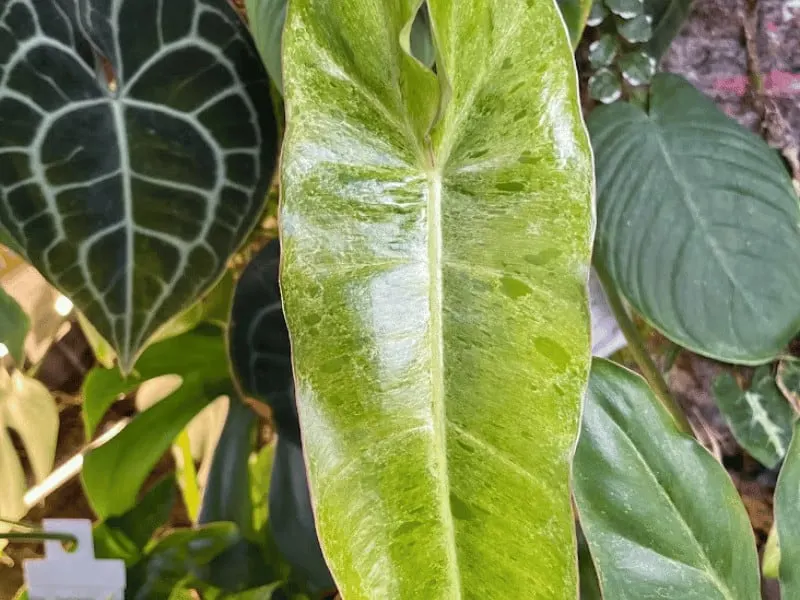
Tips for Growing Philodendron Paraiso Verde
- Place in average temperatures above the 55 degree-Fahrenheit mark.
- Avoid over and underwatering the plant and place it in a container with good drainage.
- Prune only when the plant has stunted growth or overgrows its designated space.
- Place in bright, dappled sunlight for greener leaves.
- In case of an infection, keep the plant in isolation till it recovers fully.
Frequently Asked Questions about Philodendron Paraiso Verde Plant Care
How do you take care of a Philodendron Paraiso plant?
The Philodendron Paraiso plant thrives in warm, humid environments. Maintain hydration by keeping its soil moist and watering the plant every other day. Place the plant in bright, dappled sunlight for the healthiest, greenest leaves.
Is the Philodendron Paraiso plant fast-growing?
The Philodendron Paraiso plant’s growth is primarily dependent on its surroundings. Several factors, including the right soil type, good-quality fertilizer, adequate humidity, and indirect light, play major roles.
Is the Paraiso plant a true Philodendron?
The Philodendron Paraiso, featuring beautiful variegated foliage, is also known as Marina Ruy Barbosa. It is a true climbing Philodendron with elongated, lobed leaves.
Is the Philodendron Paraiso plant rare?
The Paraiso plant is among the rarest Philodendrons due to its stunning variegated foliage. Compared to low cultivation, its great demand makes it a rare Philodendron.
Is Philodendron Paraiso a climber or terrestrial plant?
The Philodendron Paraiso is a climbing plant with elongated, marbled variegation.
Conclusion
The Philodendron Paraiso plant is relatively manageable and fond of temperate environments. It enjoys bright, filtered sunlight, watering every few days, and high-quality fertilizers.
Use feeds with a balanced NPK ratio for the healthiest growth and grow the plant outdoors.
It is toxic to pets; therefore, ensure they admire this beauty from afar.

Daniel has been a plant enthusiast for over 20 years. He owns hundreds of houseplants and prepares for the chili growing seasons yearly with great anticipation. His favorite plants are plant species in the Araceae family, such as Monstera, Philodendron, and Anthurium. He also loves gardening and is growing hot peppers, tomatoes, and many more vegetables.

